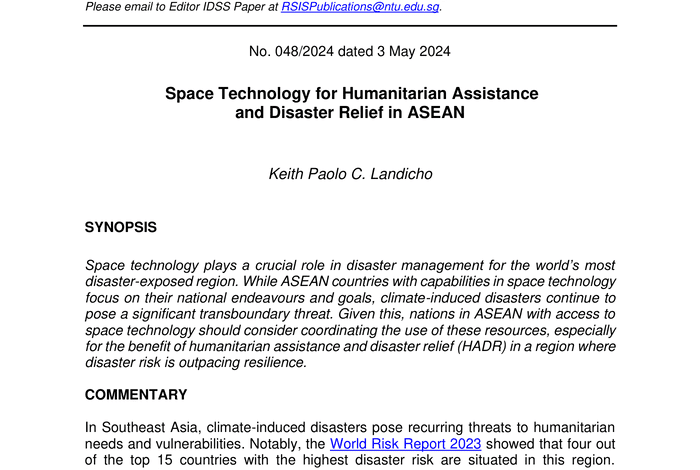Space Technology for Humanitarian Assistance and Disaster Relief in ASEAN – World

SYNOPSIS
Space technology plays a crucial role in disaster management in the world’s most disaster-prone region. While ASEAN countries with space technology capabilities focus on their national efforts and goals, climate-induced disasters continue to pose a significant transboundary threat. Given this, ASEAN nations with access to space technology should consider coordinating the use of these resources, especially for the benefit of humanitarian assistance and disaster relief (HADR) in a region where disaster risk is outpacing resilience.
COMMENT
www.rsis.edu.sg No. 048 – 3 May 2024 The views of the authors are their own and do not represent the official position of the Institute of Defense and Strategic Studies, S. Rajaratnam School of International Studies, NTU. These comments may be reproduced with prior authorization from RSIS and due acknowledgment to the authors and RSIS.
Email the IDSS Paper Editor at RSISPublications@ntu.edu.sg.
No. 048/2024 dated May 3, 2024 Space Technology for Humanitarian Assistance and Disaster Relief in ASEAN Keith Paolo C. Landicho SYNOPSIS Space technology plays a crucial role in disaster management in the world’s most disaster-exposed region. While ASEAN countries with space technology capabilities focus on their national efforts and goals, climate-induced disasters continue to pose a significant transboundary threat. Given this, ASEAN nations with access to space technology should consider coordinating the use of these resources, especially for the benefit of humanitarian assistance and disaster relief (HADR) in a region where disaster risk is outpacing resilience.
COMMENT
In Southeast Asia, climate-induced disasters pose recurring threats to humanitarian needs and vulnerabilities. Namely, the 2023 World Risk Report showed that four of the 15 countries most at risk of catastrophe are located in this region.
Additionally, disaster risks such as extreme weather events are expected to continue to have a significant impact over the next 2- and 10-year periods, according to the 2024 Global Risks Report.
Climate-induced catastrophes such as droughts, floods and tropical cyclones are increasingly devastating, resulting in transboundary impacts in the region. Such impacts present challenges that highlight the importance of collaboration and cooperation. A report from the ASEAN Secretariat highlights this need, employing a methodology that integrates probability models and satellite imagery to assess cross-border risks and plan scenarios accordingly.
Other forms of space technology, such as Earth observation, location services and satellite communications, have also been instrumental in HADR efforts to respond to these climate-induced catastrophes. Earth observation data is used to aid rapid damage assessment and inform predictive models to mitigate future disasters.
Global Positioning System (GPS) location services are vital in search and rescue operations. Satellite communications also provide essential connectivity in disaster-affected areas. These tools not only identify the threat of cross-border and climate-induced disaster risks, but also highlight the value of space technology in responding to these challenges.
These opportunities presented by space technology have reinforced coordination and response efforts, showing that this technology has the potential to bridge existing gaps and promote more concerted actions to solve complex regional problems.


